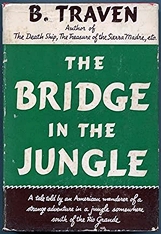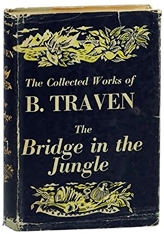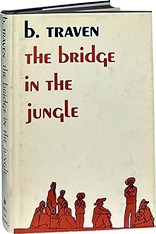Mon 10 Jun 2024
Reviewed by Tony Baer: B. TRAVEN – The Bridge in the Jungle.
Posted by Steve under Reviews[3] Comments

B. TRAVEN – The Bridge in the Jungle. Serialized in Vorwärts in 1927 (in German) and published in an extended book form in 1929. Knopf, 1st US edition, hardcover, 1938. Reprinted several times. Originally written as a short story and intended to be the title piece of Traven’s short story collection The Collected Works of B. Traven: The Bridge in the Jungle. Available online at the Internet Archive website. Film: United Artists, 1971.
Told in the first person, our American narrator is hunting alligators in the Mexican jungles. Makeshift native settlements dot the river banks. In one such settlement, our narrator runs into an acquaintance of his, another gringo named ‘Sleigh’ who has married into the community. He decides to stay for a couple of nights.
There is a pump station there that runs water to the railroads. The pump station attendant has the status of local royalty as he has the finest of huts, an actual mattress to sleep on, and pots and pans to cook with. Once in a while the pump station attendant brings in beer and soda and some musicians for a party and sells the beer and soda for a little profit. Such a party is scheduled for tonight.

For the party, a young man returns for the weekend from the Texas oil fields to flaunt his riches, sow his oats, and play with his little brother Carlosito who worships him. He comes bearing gifts: a beautiful shining black pair of shoes for Carlosito. The first shoes the child has ever had. He is tremendously excited to put them on and show them off — yet for a boy who has never worn shoes before, the shoes prove to be a bit of an encumbrance to the boy’s exuberant comings and goings and jumping around.
Between the pump station and the settlement is a rickety old bridge without any railings, the 12 foot deep river running beneath.
The party begins, and villagers from all around descend upon the pump station, hazarding the bridge in the pitch jungle darkness. The mood is festive, there’s laughter, giggling girls, coy boys, dancing and gossip.
And then Carlosito disappears.
At first the disappearance and the mother’s fears are dismissed: it’s only been half an hour; boys will hide and run away — but they always come back. But as the hours pass and the boy fails to return, the mother’s fears turn more and more hysterical, while the grounds for her hysteria become harder and harder to dismiss.

It’s a powerful story of the depths of maternal love and grief and the interpersonal scope of tribal motherhood where every mother in the village shares trepidation and grief, joining the aggrieved in union, in unison, giving everything they have despite their squalor, for no other reason than love.
I liked it. Maybe not as much as I loved Death Ship (which to me is one of the best books ever). Nor was there the breadth of adventure and psychopathology of Treasure of the Sierra Madre, nor the Death Ship-lite sarcastic voice of The Cotton Pickers. But there is a purity here presenting the native maternal heritage where one rightly wonders whether civilization has wrought a more or less civilized humanity as we struggle through love and loss, together and alone.
June 11th, 2024 at 1:55 am
B. Traven’s Wikipedia page is here below. It’s long and detailed and even if you thought you knew everything you needed to know about him, I’m willing to wager that you don’t.
https://en.wikipedia.org/wiki/B._Traven
Here’s the first paragraph:
“B. Traven (German: [ˈbeː ˈtʁaːvn̩]; Bruno Traven in some accounts) was the pen name of a novelist, presumed to be German, whose real name, nationality, date and place of birth and details of biography are all subject to dispute. One certainty about Traven’s life is that he lived for years in Mexico, where the majority of his fiction is also set—including The Treasure of the Sierra Madre (1927), the film adaptation of which won three Academy Awards in 1949.”
June 13th, 2024 at 6:24 pm
‘Death Ship’ I may have initially heard about right here on MysteryFile but wherever I heard about it, it immediately soared to the highest tier of my all-time favorite works, upon reading. At this late date for any novel to leapfrog into my shortlist of top-twenty-or-so all-time greatest picks from world literature, is unheard of.
Traven is a powerhouse, a dynamo.
June 15th, 2024 at 12:09 am
There is an interesting sidelight on the hunt for the reclusive Traven involving Harlan Ellison, who wrote about it.
Traven is probably best taken in small doses, the weight of his tales lose a little something if read too close together. After DEATH SHIP I needed a day or two before tackling anything else.